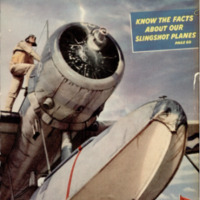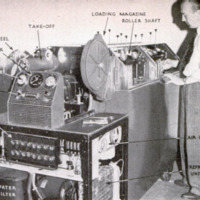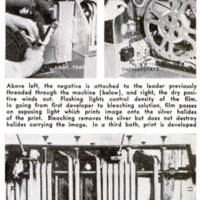High-speed film pocesser
Item
-
Title (Dublin Core)
-
High-speed film pocesser
-
Article Title and/or Image Caption (Dublin Core)
-
Army gets high-speed film processer
-
extracted text (Extract Text)
-
TO SPEED study of enemy
installations by our mili
tary commanders, a portable
machine produced by H. W.
Houston & Co., of Los An-
geles, Calif, has been de-
signed to process movie film
and have it ready for view-
ing in 30 minutes. Capable
of handling 16-mm. black-
and-white film at the rate of
900 feet a minute, the ma-
chine can operate in full day-
light. After the negative has
been loaded into a light-tight
‘magazine in a portable dark-
room, the magazine is placed
in the machine, and from
there the film passes auto-
matically through all the
various processing compart-
ments. Refrigerating and
heating units keep solutions
at proper temperature, and
filtered air is used in the dry-
ing compartment. Chemicals
are supplied to photographic
units in measured packages.
All the operator needs to do
is to attach electric power
and water lines, insert the
negative, push a button, and
wait for the dry positive to
wind out on a waiting reel.
A ROLLING STEEL DOOR, which, when
shut, acts as the rear wall of a seven-
story building, has recently been com-
pleted by the Kinnear Manufacturing
Co, of Columbus, Ohio. Construction
of the door was occasioned by having
to move a 120-ton overhead crane in
and out of the building. Made up of
interlocking slats, the door opens and
shuts by sliding up and down. When
drawn up, it coils into a compact cylin-
der in a small housing on the roof. An
unusual safety feature is the air-con-
taining weather strip at the bottom of
the door. By means of pneumatic ac-
tion, this strip automatically halts or
reverses the descending door the instant
it comes Into contact with an object.
Actually a curtain of steel, the door is
extremely durable, and is constructed
0 that repairs can be made easily.
Smoothness of operation of the gigantic
door is attained by means of delicate
spring _counterbalancing as well as
through electric control,
BICYCLE-PEDAL REFLECTORS that throw back the
light from the headlamps of approaching vehi-
cles have been invented by Morris Rider, of
Detroit, Mich, as a safety device for night-
riding cyclists. Mountings easily attached to
the pedals contain six reflecting faces apiece,
set at various angles to pick up light coming
from any direction. Bossings or raised portions
of the mountings keep the rider's feet in line
on the pedals and prevent interference.
PLASTIC TREADS made by Monsanto
Chemical Company from a phenol-
formaldehyde compound are re-
placing rubber tires on small hand-
pushed trucks. Although less resili-
ent and a bit noisier than rubber,
the plastic treads roll more easily
over smooth and rough surfaces,
are easier to attach to a wheel, and
apparently are resistant to the
hardest kind of usage.
-
Language (Dublin Core)
-
eng
-
Date Issued (Dublin Core)
-
1943-05
-
pages (Bibliographic Ontology)
-
115-116
-
Rights (Dublin Core)
-
Public Domain (Google Digitized)
-
Archived by (Dublin Core)
-
Matteo Ridolfi
-
Marco Bortolami (editor)
 Popular Science Monthly, v. 142, n. 5, 1943
Popular Science Monthly, v. 142, n. 5, 1943




